Microeconomics Assignment: Sugar Tax and Externalities
VerifiedAdded on 2021/06/17
|15
|2474
|439
Homework Assignment
AI Summary
This microeconomics assignment analyzes the economic implications of sugar taxes, focusing on the concepts of negative externalities and the application of Pigouvian taxes as a solution to market inefficiencies. The assignment examines how sugar taxes impact demand and supply, leading to changes in market equilibrium and potential deadweight loss. It uses the example of the UK's sugar tax on sugary drinks, like Coca-Cola, to illustrate how such policies aim to address public health problems and reduce consumption. The analysis considers the tax's effects on consumer behavior and market outcomes, as well as the broader implications for income inequality. The paper explores the role of government intervention in correcting market failures and the trade-offs involved in implementing such policies, including potential impacts on different income groups. The assignment uses diagrams to illustrate key economic concepts and provides a comprehensive overview of the economic rationale and consequences of sugar taxes.
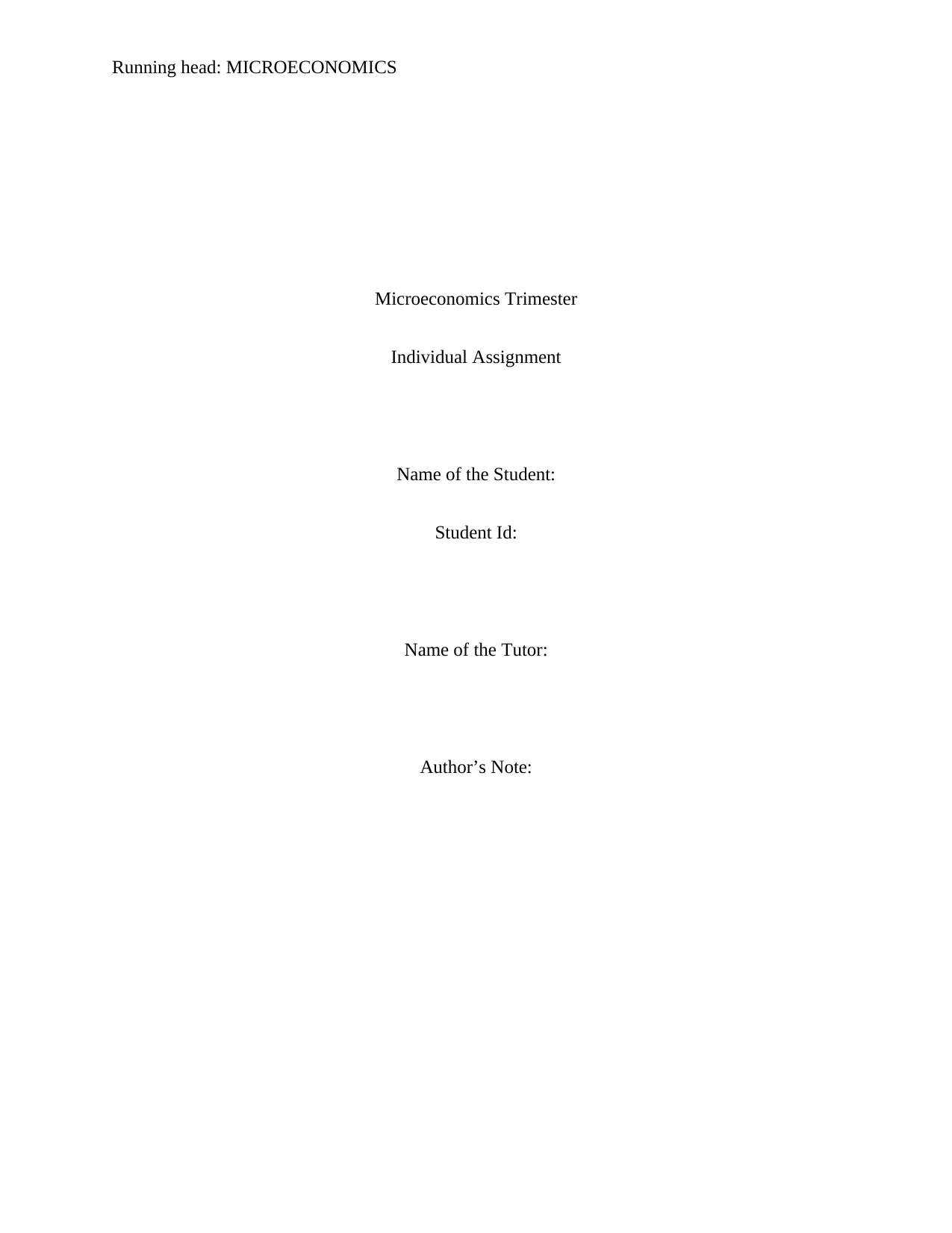
Running head: MICROECONOMICS
Microeconomics Trimester
Individual Assignment
Name of the Student:
Student Id:
Name of the Tutor:
Author’s Note:
Microeconomics Trimester
Individual Assignment
Name of the Student:
Student Id:
Name of the Tutor:
Author’s Note:
Paraphrase This Document
Need a fresh take? Get an instant paraphrase of this document with our AI Paraphraser
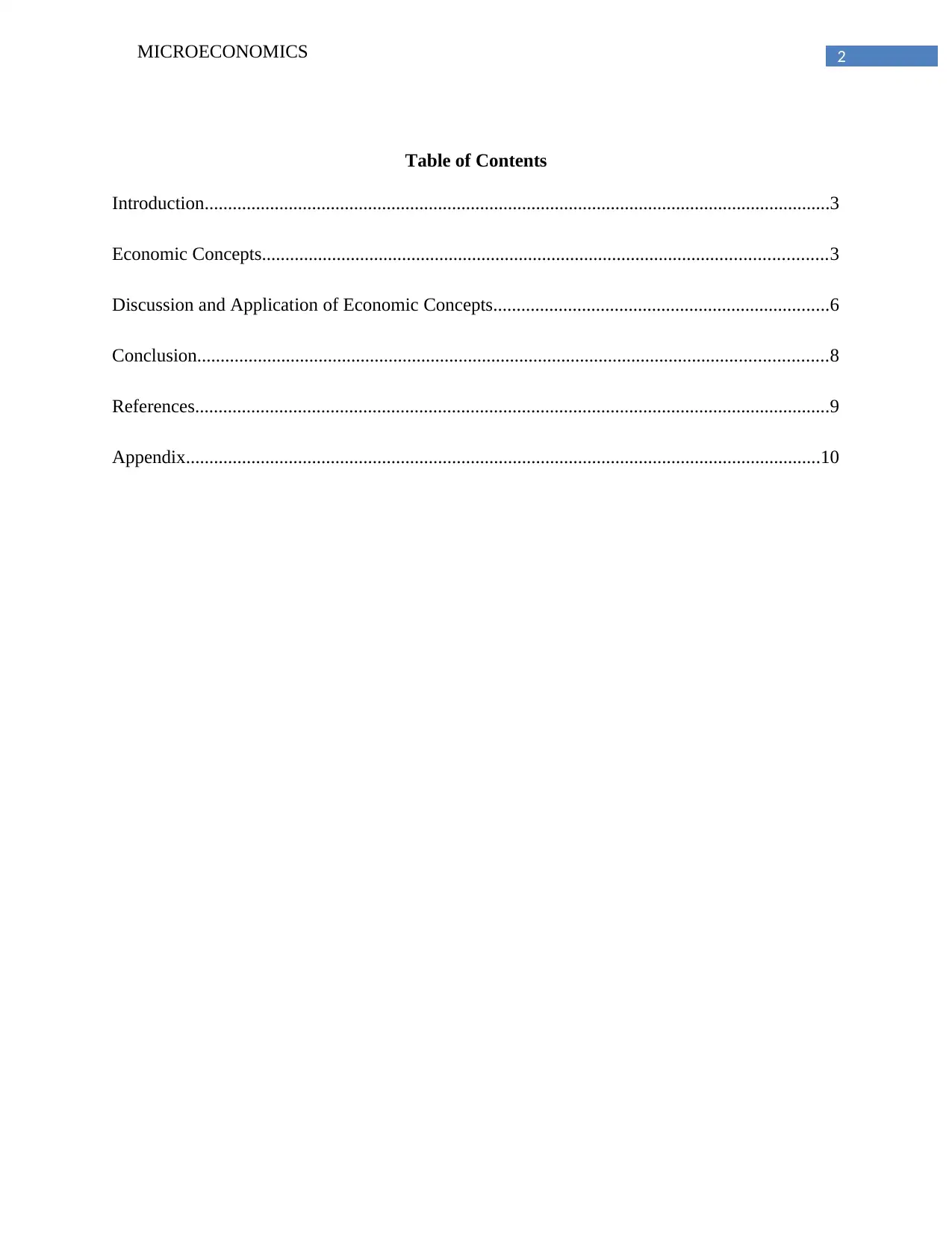
2MICROECONOMICS
Table of Contents
Introduction......................................................................................................................................3
Economic Concepts.........................................................................................................................3
Discussion and Application of Economic Concepts........................................................................6
Conclusion.......................................................................................................................................8
References........................................................................................................................................9
Appendix........................................................................................................................................10
Table of Contents
Introduction......................................................................................................................................3
Economic Concepts.........................................................................................................................3
Discussion and Application of Economic Concepts........................................................................6
Conclusion.......................................................................................................................................8
References........................................................................................................................................9
Appendix........................................................................................................................................10
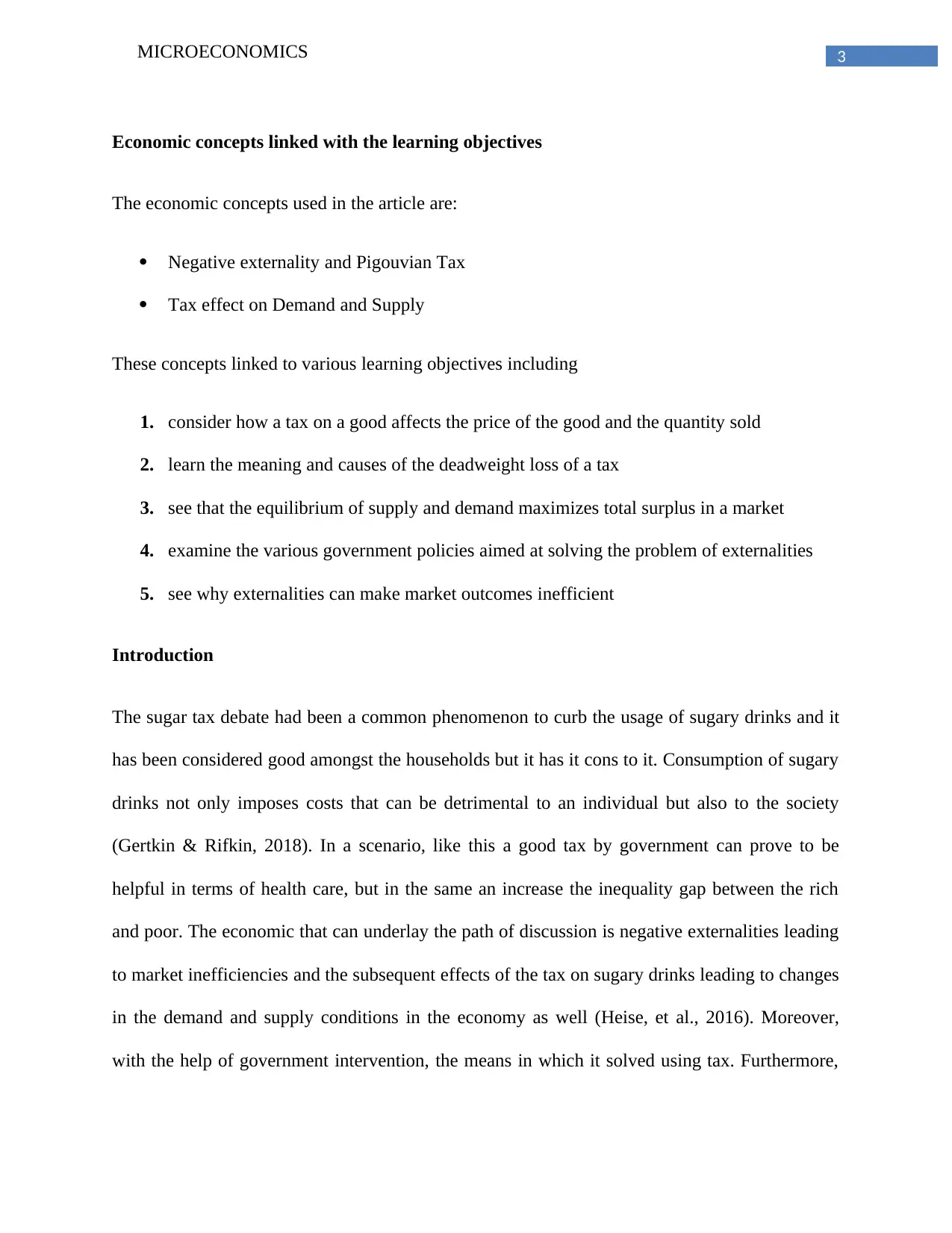
3MICROECONOMICS
Economic concepts linked with the learning objectives
The economic concepts used in the article are:
Negative externality and Pigouvian Tax
Tax effect on Demand and Supply
These concepts linked to various learning objectives including
1. consider how a tax on a good affects the price of the good and the quantity sold
2. learn the meaning and causes of the deadweight loss of a tax
3. see that the equilibrium of supply and demand maximizes total surplus in a market
4. examine the various government policies aimed at solving the problem of externalities
5. see why externalities can make market outcomes inefficient
Introduction
The sugar tax debate had been a common phenomenon to curb the usage of sugary drinks and it
has been considered good amongst the households but it has it cons to it. Consumption of sugary
drinks not only imposes costs that can be detrimental to an individual but also to the society
(Gertkin & Rifkin, 2018). In a scenario, like this a good tax by government can prove to be
helpful in terms of health care, but in the same an increase the inequality gap between the rich
and poor. The economic that can underlay the path of discussion is negative externalities leading
to market inefficiencies and the subsequent effects of the tax on sugary drinks leading to changes
in the demand and supply conditions in the economy as well (Heise, et al., 2016). Moreover,
with the help of government intervention, the means in which it solved using tax. Furthermore,
Economic concepts linked with the learning objectives
The economic concepts used in the article are:
Negative externality and Pigouvian Tax
Tax effect on Demand and Supply
These concepts linked to various learning objectives including
1. consider how a tax on a good affects the price of the good and the quantity sold
2. learn the meaning and causes of the deadweight loss of a tax
3. see that the equilibrium of supply and demand maximizes total surplus in a market
4. examine the various government policies aimed at solving the problem of externalities
5. see why externalities can make market outcomes inefficient
Introduction
The sugar tax debate had been a common phenomenon to curb the usage of sugary drinks and it
has been considered good amongst the households but it has it cons to it. Consumption of sugary
drinks not only imposes costs that can be detrimental to an individual but also to the society
(Gertkin & Rifkin, 2018). In a scenario, like this a good tax by government can prove to be
helpful in terms of health care, but in the same an increase the inequality gap between the rich
and poor. The economic that can underlay the path of discussion is negative externalities leading
to market inefficiencies and the subsequent effects of the tax on sugary drinks leading to changes
in the demand and supply conditions in the economy as well (Heise, et al., 2016). Moreover,
with the help of government intervention, the means in which it solved using tax. Furthermore,
⊘ This is a preview!⊘
Do you want full access?
Subscribe today to unlock all pages.

Trusted by 1+ million students worldwide
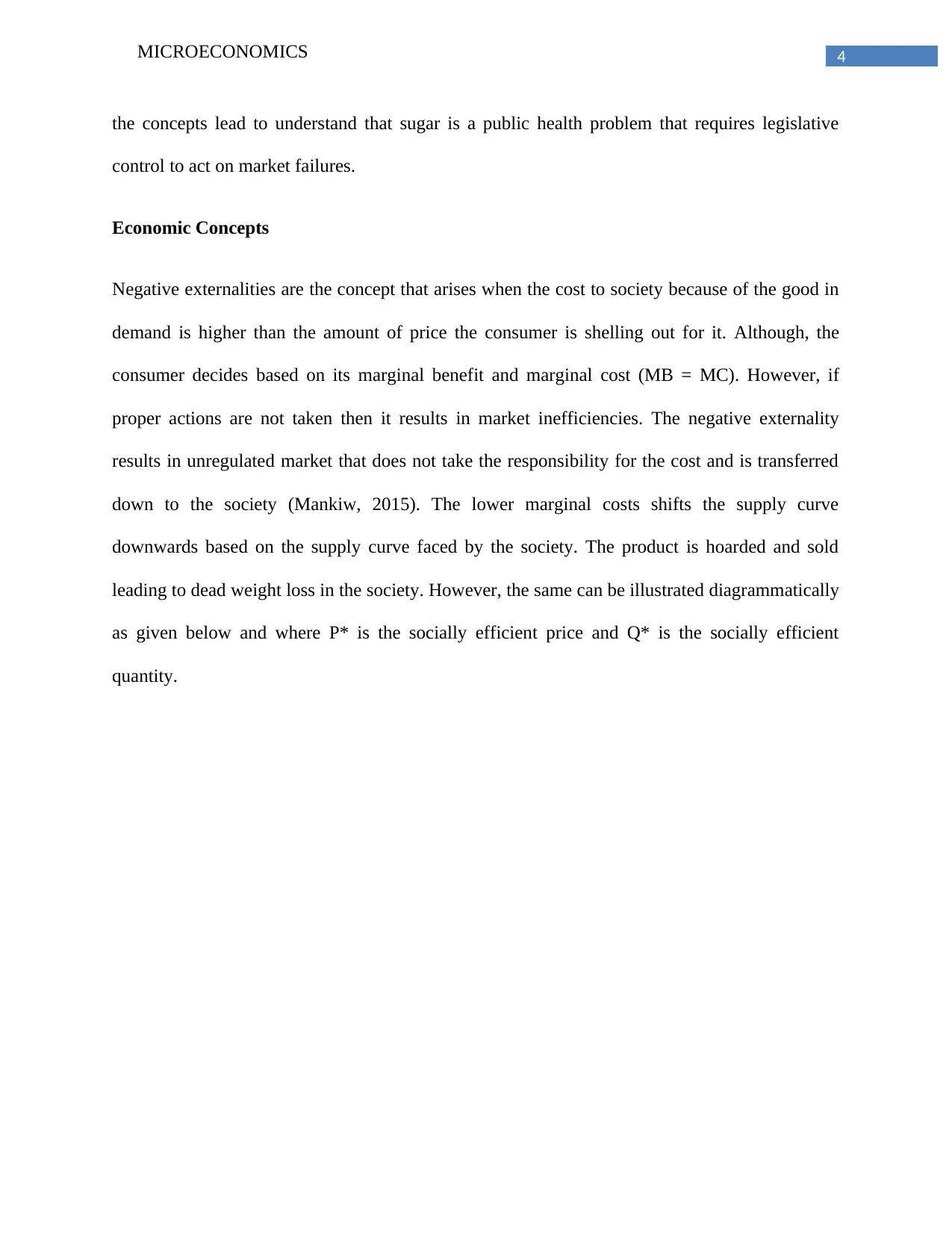
4MICROECONOMICS
the concepts lead to understand that sugar is a public health problem that requires legislative
control to act on market failures.
Economic Concepts
Negative externalities are the concept that arises when the cost to society because of the good in
demand is higher than the amount of price the consumer is shelling out for it. Although, the
consumer decides based on its marginal benefit and marginal cost (MB = MC). However, if
proper actions are not taken then it results in market inefficiencies. The negative externality
results in unregulated market that does not take the responsibility for the cost and is transferred
down to the society (Mankiw, 2015). The lower marginal costs shifts the supply curve
downwards based on the supply curve faced by the society. The product is hoarded and sold
leading to dead weight loss in the society. However, the same can be illustrated diagrammatically
as given below and where P* is the socially efficient price and Q* is the socially efficient
quantity.
the concepts lead to understand that sugar is a public health problem that requires legislative
control to act on market failures.
Economic Concepts
Negative externalities are the concept that arises when the cost to society because of the good in
demand is higher than the amount of price the consumer is shelling out for it. Although, the
consumer decides based on its marginal benefit and marginal cost (MB = MC). However, if
proper actions are not taken then it results in market inefficiencies. The negative externality
results in unregulated market that does not take the responsibility for the cost and is transferred
down to the society (Mankiw, 2015). The lower marginal costs shifts the supply curve
downwards based on the supply curve faced by the society. The product is hoarded and sold
leading to dead weight loss in the society. However, the same can be illustrated diagrammatically
as given below and where P* is the socially efficient price and Q* is the socially efficient
quantity.
Paraphrase This Document
Need a fresh take? Get an instant paraphrase of this document with our AI Paraphraser
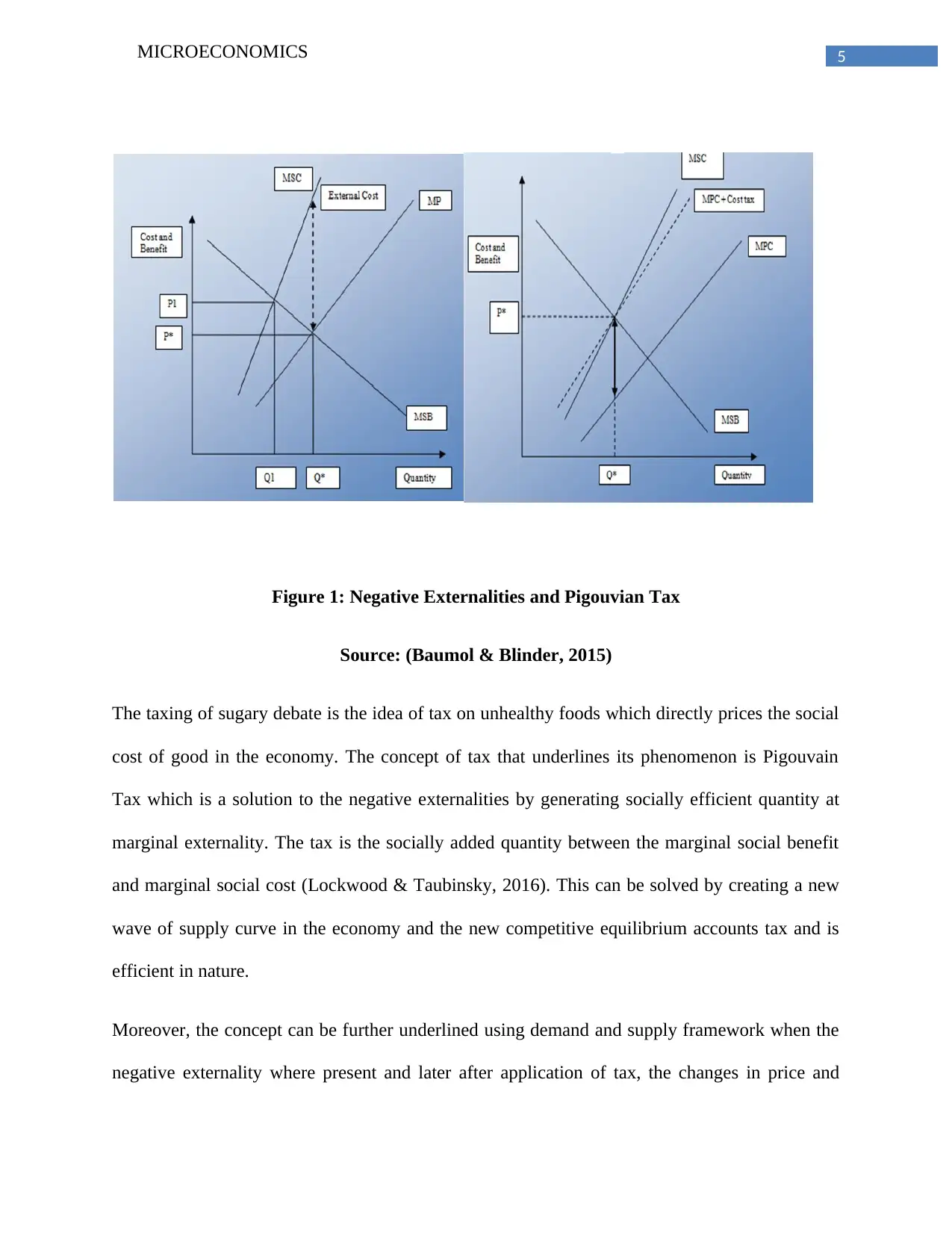
5MICROECONOMICS
Figure 1: Negative Externalities and Pigouvian Tax
Source: (Baumol & Blinder, 2015)
The taxing of sugary debate is the idea of tax on unhealthy foods which directly prices the social
cost of good in the economy. The concept of tax that underlines its phenomenon is Pigouvain
Tax which is a solution to the negative externalities by generating socially efficient quantity at
marginal externality. The tax is the socially added quantity between the marginal social benefit
and marginal social cost (Lockwood & Taubinsky, 2016). This can be solved by creating a new
wave of supply curve in the economy and the new competitive equilibrium accounts tax and is
efficient in nature.
Moreover, the concept can be further underlined using demand and supply framework when the
negative externality where present and later after application of tax, the changes in price and
Figure 1: Negative Externalities and Pigouvian Tax
Source: (Baumol & Blinder, 2015)
The taxing of sugary debate is the idea of tax on unhealthy foods which directly prices the social
cost of good in the economy. The concept of tax that underlines its phenomenon is Pigouvain
Tax which is a solution to the negative externalities by generating socially efficient quantity at
marginal externality. The tax is the socially added quantity between the marginal social benefit
and marginal social cost (Lockwood & Taubinsky, 2016). This can be solved by creating a new
wave of supply curve in the economy and the new competitive equilibrium accounts tax and is
efficient in nature.
Moreover, the concept can be further underlined using demand and supply framework when the
negative externality where present and later after application of tax, the changes in price and
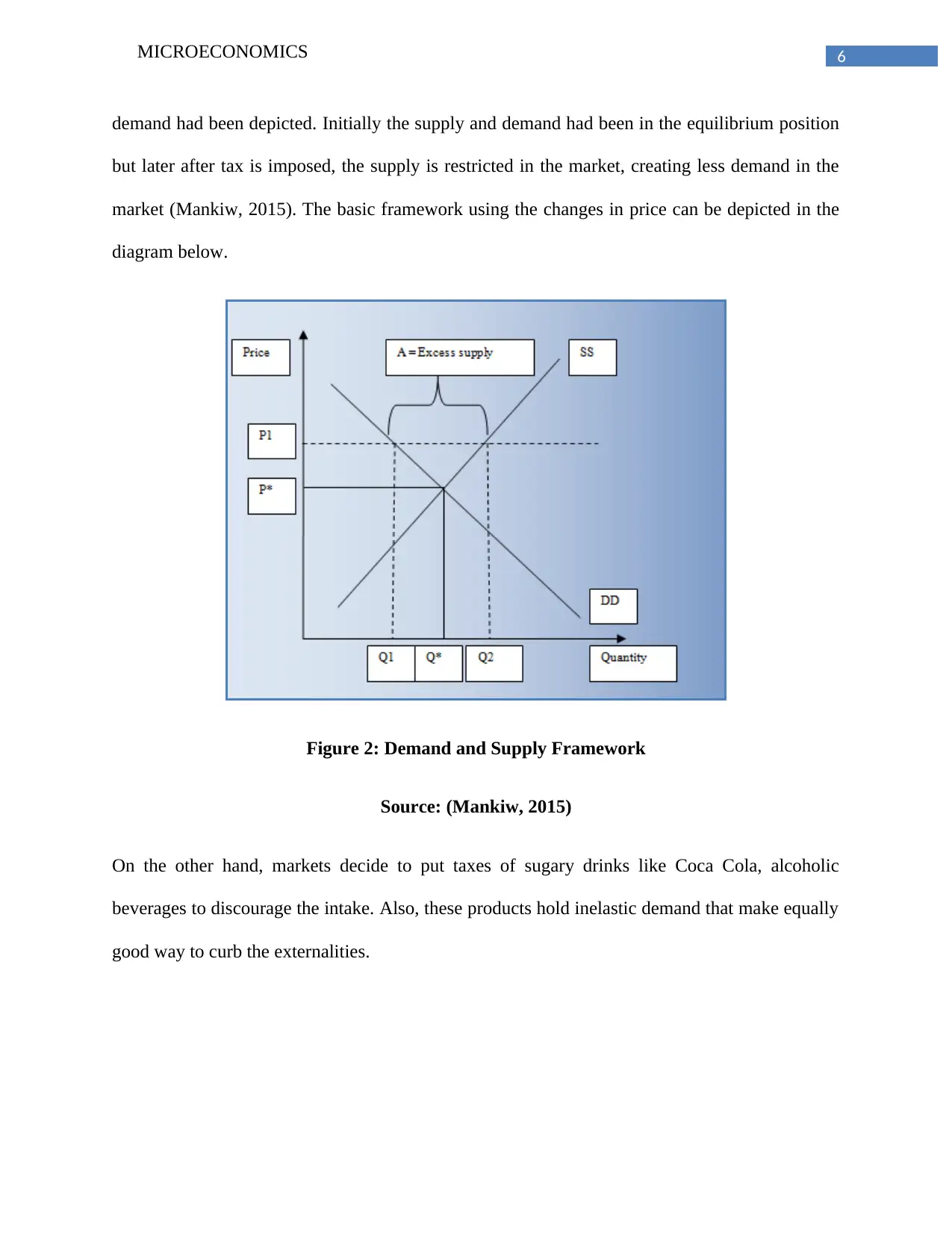
6MICROECONOMICS
demand had been depicted. Initially the supply and demand had been in the equilibrium position
but later after tax is imposed, the supply is restricted in the market, creating less demand in the
market (Mankiw, 2015). The basic framework using the changes in price can be depicted in the
diagram below.
Figure 2: Demand and Supply Framework
Source: (Mankiw, 2015)
On the other hand, markets decide to put taxes of sugary drinks like Coca Cola, alcoholic
beverages to discourage the intake. Also, these products hold inelastic demand that make equally
good way to curb the externalities.
demand had been depicted. Initially the supply and demand had been in the equilibrium position
but later after tax is imposed, the supply is restricted in the market, creating less demand in the
market (Mankiw, 2015). The basic framework using the changes in price can be depicted in the
diagram below.
Figure 2: Demand and Supply Framework
Source: (Mankiw, 2015)
On the other hand, markets decide to put taxes of sugary drinks like Coca Cola, alcoholic
beverages to discourage the intake. Also, these products hold inelastic demand that make equally
good way to curb the externalities.
⊘ This is a preview!⊘
Do you want full access?
Subscribe today to unlock all pages.

Trusted by 1+ million students worldwide
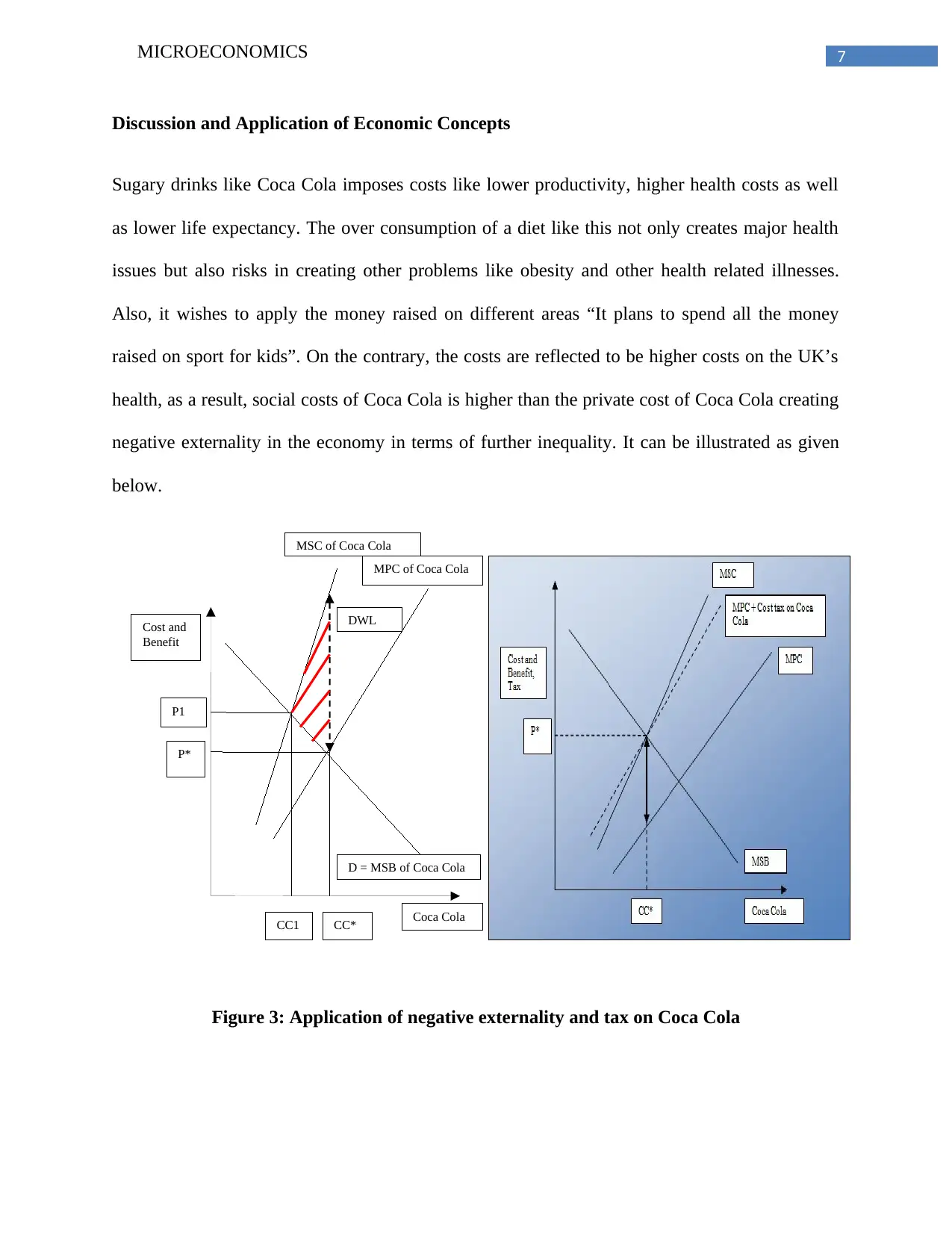
7MICROECONOMICS
Coca Cola
Cost and
Benefit
D = MSB of Coca Cola
CC*CC1
MPC of Coca Cola
MSC of Coca Cola
DWL
P1
P*
Discussion and Application of Economic Concepts
Sugary drinks like Coca Cola imposes costs like lower productivity, higher health costs as well
as lower life expectancy. The over consumption of a diet like this not only creates major health
issues but also risks in creating other problems like obesity and other health related illnesses.
Also, it wishes to apply the money raised on different areas “It plans to spend all the money
raised on sport for kids”. On the contrary, the costs are reflected to be higher costs on the UK’s
health, as a result, social costs of Coca Cola is higher than the private cost of Coca Cola creating
negative externality in the economy in terms of further inequality. It can be illustrated as given
below.
Figure 3: Application of negative externality and tax on Coca Cola
Coca Cola
Cost and
Benefit
D = MSB of Coca Cola
CC*CC1
MPC of Coca Cola
MSC of Coca Cola
DWL
P1
P*
Discussion and Application of Economic Concepts
Sugary drinks like Coca Cola imposes costs like lower productivity, higher health costs as well
as lower life expectancy. The over consumption of a diet like this not only creates major health
issues but also risks in creating other problems like obesity and other health related illnesses.
Also, it wishes to apply the money raised on different areas “It plans to spend all the money
raised on sport for kids”. On the contrary, the costs are reflected to be higher costs on the UK’s
health, as a result, social costs of Coca Cola is higher than the private cost of Coca Cola creating
negative externality in the economy in terms of further inequality. It can be illustrated as given
below.
Figure 3: Application of negative externality and tax on Coca Cola
Paraphrase This Document
Need a fresh take? Get an instant paraphrase of this document with our AI Paraphraser
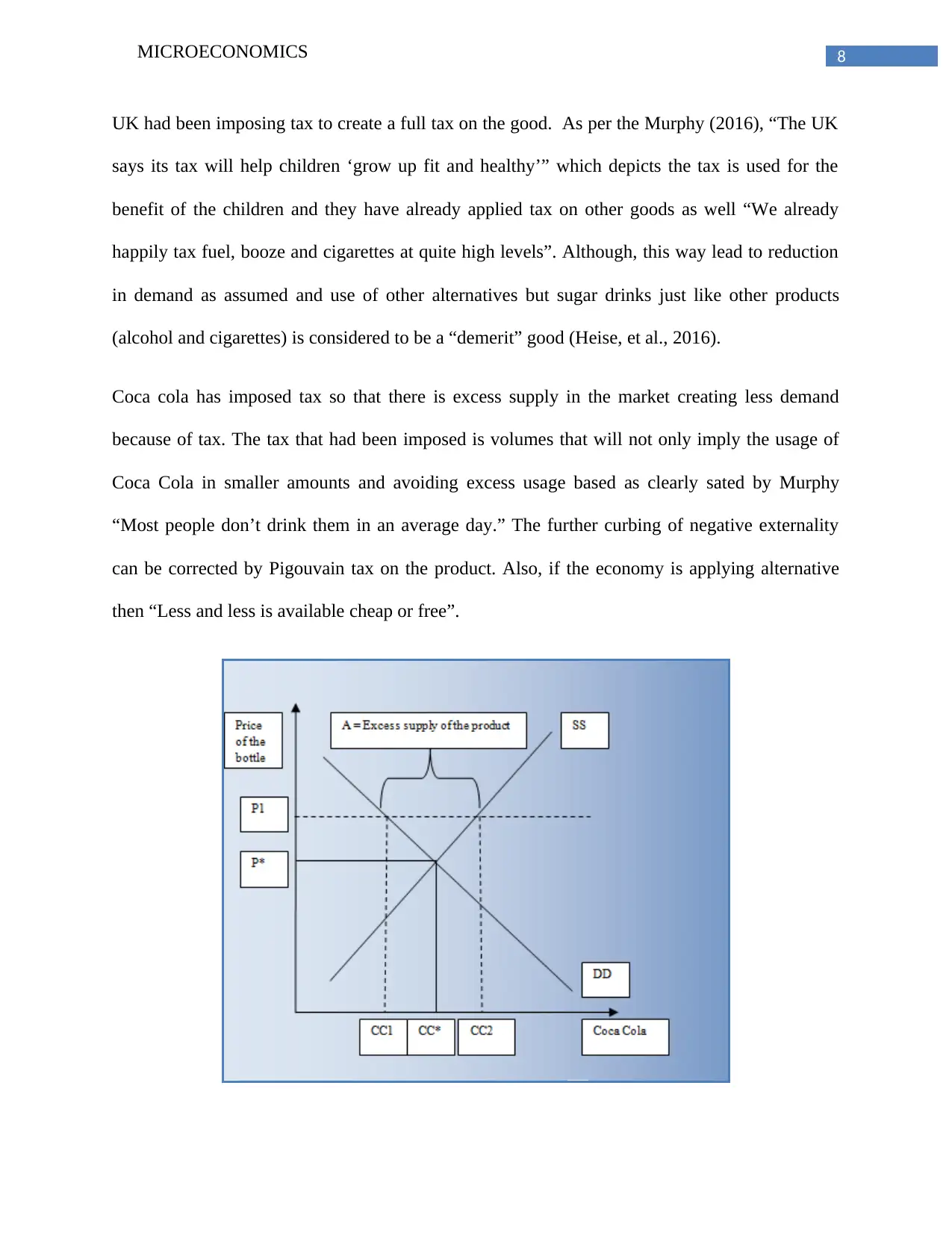
8MICROECONOMICS
UK had been imposing tax to create a full tax on the good. As per the Murphy (2016), “The UK
says its tax will help children ‘grow up fit and healthy’” which depicts the tax is used for the
benefit of the children and they have already applied tax on other goods as well “We already
happily tax fuel, booze and cigarettes at quite high levels”. Although, this way lead to reduction
in demand as assumed and use of other alternatives but sugar drinks just like other products
(alcohol and cigarettes) is considered to be a “demerit” good (Heise, et al., 2016).
Coca cola has imposed tax so that there is excess supply in the market creating less demand
because of tax. The tax that had been imposed is volumes that will not only imply the usage of
Coca Cola in smaller amounts and avoiding excess usage based as clearly sated by Murphy
“Most people don’t drink them in an average day.” The further curbing of negative externality
can be corrected by Pigouvain tax on the product. Also, if the economy is applying alternative
then “Less and less is available cheap or free”.
UK had been imposing tax to create a full tax on the good. As per the Murphy (2016), “The UK
says its tax will help children ‘grow up fit and healthy’” which depicts the tax is used for the
benefit of the children and they have already applied tax on other goods as well “We already
happily tax fuel, booze and cigarettes at quite high levels”. Although, this way lead to reduction
in demand as assumed and use of other alternatives but sugar drinks just like other products
(alcohol and cigarettes) is considered to be a “demerit” good (Heise, et al., 2016).
Coca cola has imposed tax so that there is excess supply in the market creating less demand
because of tax. The tax that had been imposed is volumes that will not only imply the usage of
Coca Cola in smaller amounts and avoiding excess usage based as clearly sated by Murphy
“Most people don’t drink them in an average day.” The further curbing of negative externality
can be corrected by Pigouvain tax on the product. Also, if the economy is applying alternative
then “Less and less is available cheap or free”.
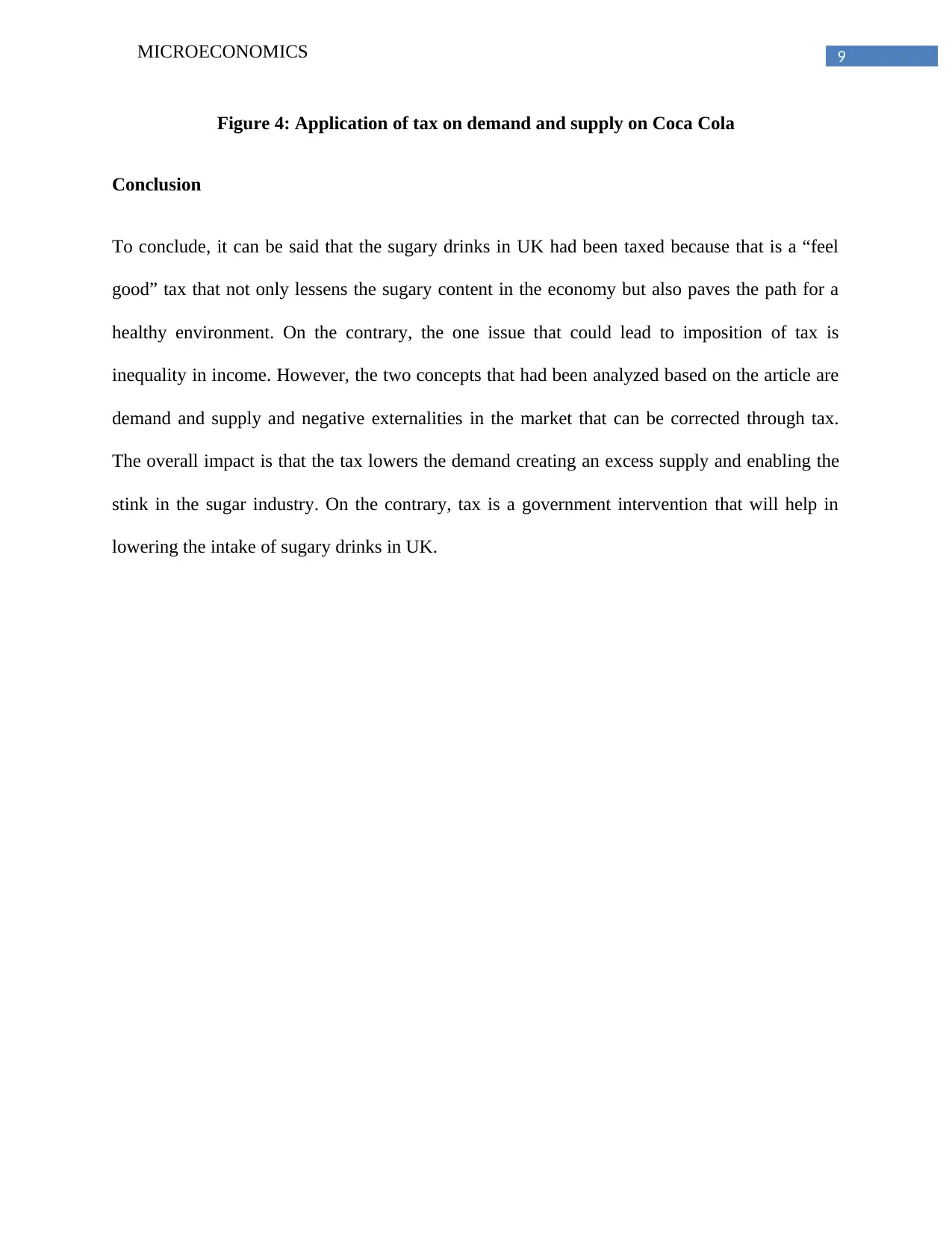
9MICROECONOMICS
Figure 4: Application of tax on demand and supply on Coca Cola
Conclusion
To conclude, it can be said that the sugary drinks in UK had been taxed because that is a “feel
good” tax that not only lessens the sugary content in the economy but also paves the path for a
healthy environment. On the contrary, the one issue that could lead to imposition of tax is
inequality in income. However, the two concepts that had been analyzed based on the article are
demand and supply and negative externalities in the market that can be corrected through tax.
The overall impact is that the tax lowers the demand creating an excess supply and enabling the
stink in the sugar industry. On the contrary, tax is a government intervention that will help in
lowering the intake of sugary drinks in UK.
Figure 4: Application of tax on demand and supply on Coca Cola
Conclusion
To conclude, it can be said that the sugary drinks in UK had been taxed because that is a “feel
good” tax that not only lessens the sugary content in the economy but also paves the path for a
healthy environment. On the contrary, the one issue that could lead to imposition of tax is
inequality in income. However, the two concepts that had been analyzed based on the article are
demand and supply and negative externalities in the market that can be corrected through tax.
The overall impact is that the tax lowers the demand creating an excess supply and enabling the
stink in the sugar industry. On the contrary, tax is a government intervention that will help in
lowering the intake of sugary drinks in UK.
⊘ This is a preview!⊘
Do you want full access?
Subscribe today to unlock all pages.

Trusted by 1+ million students worldwide
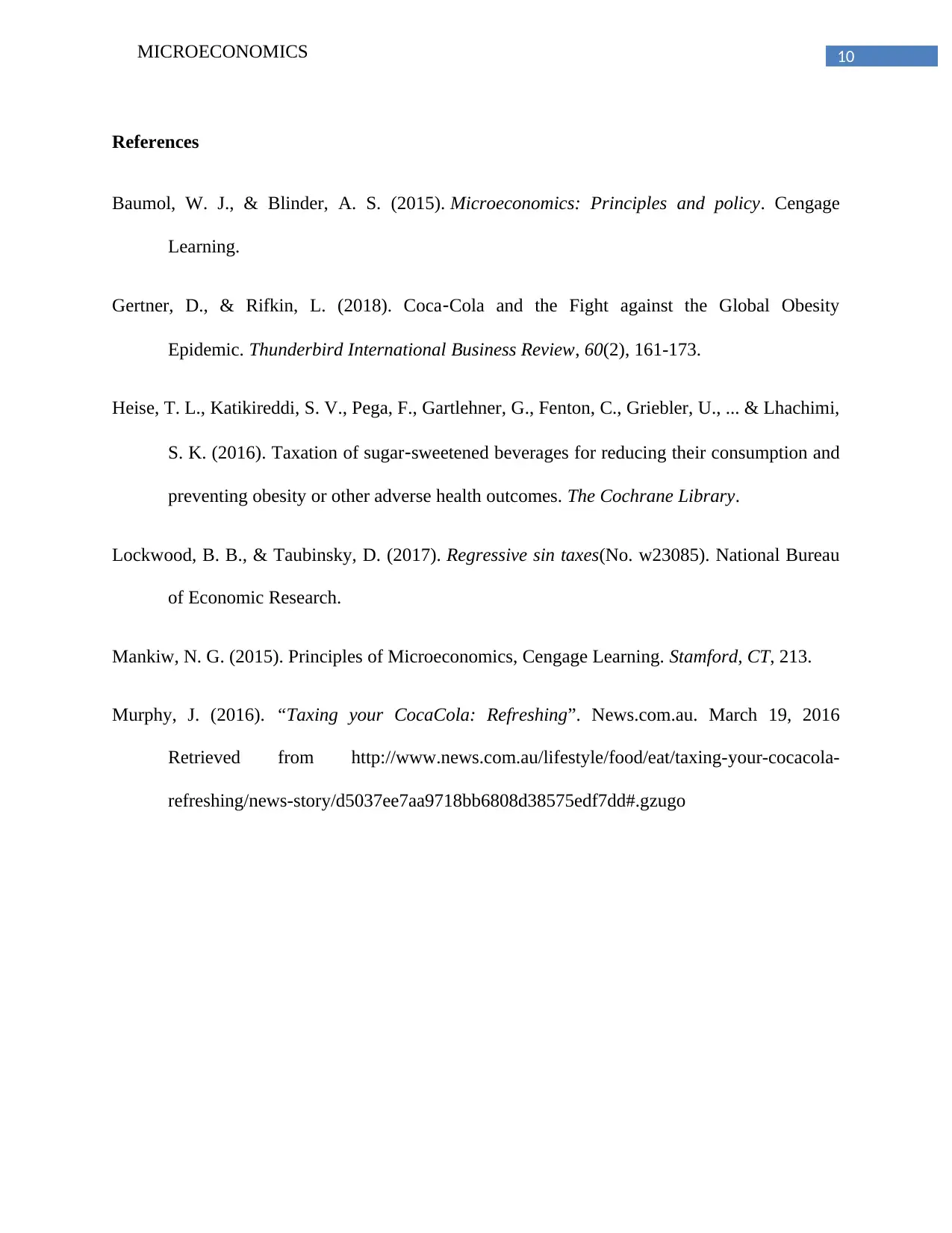
10MICROECONOMICS
References
Baumol, W. J., & Blinder, A. S. (2015). Microeconomics: Principles and policy. Cengage
Learning.
Gertner, D., & Rifkin, L. (2018). Coca‐Cola and the Fight against the Global Obesity
Epidemic. Thunderbird International Business Review, 60(2), 161-173.
Heise, T. L., Katikireddi, S. V., Pega, F., Gartlehner, G., Fenton, C., Griebler, U., ... & Lhachimi,
S. K. (2016). Taxation of sugar‐sweetened beverages for reducing their consumption and
preventing obesity or other adverse health outcomes. The Cochrane Library.
Lockwood, B. B., & Taubinsky, D. (2017). Regressive sin taxes(No. w23085). National Bureau
of Economic Research.
Mankiw, N. G. (2015). Principles of Microeconomics, Cengage Learning. Stamford, CT, 213.
Murphy, J. (2016). “Taxing your CocaCola: Refreshing”. News.com.au. March 19, 2016
Retrieved from http://www.news.com.au/lifestyle/food/eat/taxing-your-cocacola-
refreshing/news-story/d5037ee7aa9718bb6808d38575edf7dd#.gzugo
References
Baumol, W. J., & Blinder, A. S. (2015). Microeconomics: Principles and policy. Cengage
Learning.
Gertner, D., & Rifkin, L. (2018). Coca‐Cola and the Fight against the Global Obesity
Epidemic. Thunderbird International Business Review, 60(2), 161-173.
Heise, T. L., Katikireddi, S. V., Pega, F., Gartlehner, G., Fenton, C., Griebler, U., ... & Lhachimi,
S. K. (2016). Taxation of sugar‐sweetened beverages for reducing their consumption and
preventing obesity or other adverse health outcomes. The Cochrane Library.
Lockwood, B. B., & Taubinsky, D. (2017). Regressive sin taxes(No. w23085). National Bureau
of Economic Research.
Mankiw, N. G. (2015). Principles of Microeconomics, Cengage Learning. Stamford, CT, 213.
Murphy, J. (2016). “Taxing your CocaCola: Refreshing”. News.com.au. March 19, 2016
Retrieved from http://www.news.com.au/lifestyle/food/eat/taxing-your-cocacola-
refreshing/news-story/d5037ee7aa9718bb6808d38575edf7dd#.gzugo
Paraphrase This Document
Need a fresh take? Get an instant paraphrase of this document with our AI Paraphraser
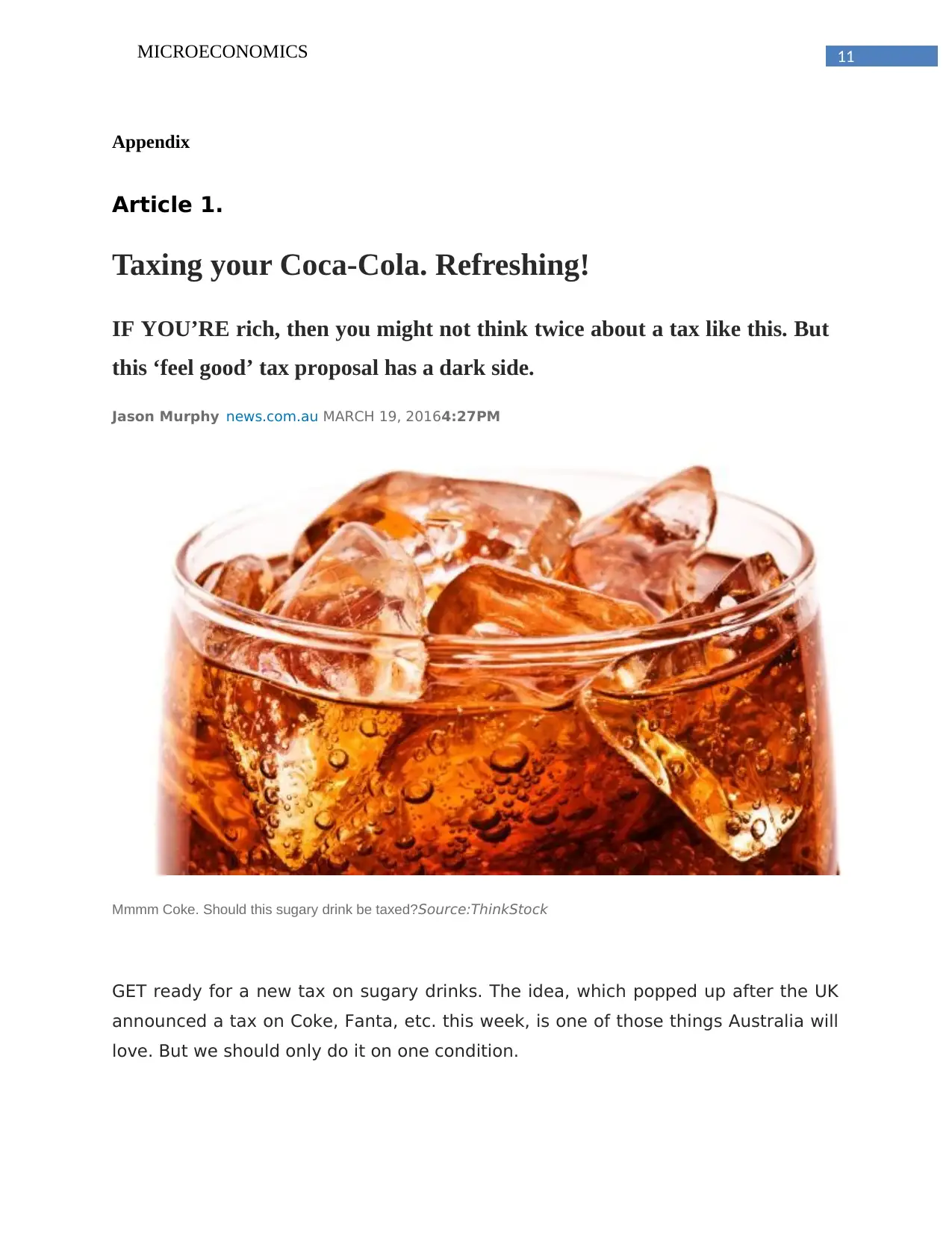
11MICROECONOMICS
Appendix
Article 1.
Taxing your Coca-Cola. Refreshing!
IF YOU’RE rich, then you might not think twice about a tax like this. But
this ‘feel good’ tax proposal has a dark side.
Jason Murphy news.com.au MARCH 19, 20164:27PM
Mmmm Coke. Should this sugary drink be taxed?Source:ThinkStock
GET ready for a new tax on sugary drinks. The idea, which popped up after the UK
announced a tax on Coke, Fanta, etc. this week, is one of those things Australia will
love. But we should only do it on one condition.
Appendix
Article 1.
Taxing your Coca-Cola. Refreshing!
IF YOU’RE rich, then you might not think twice about a tax like this. But
this ‘feel good’ tax proposal has a dark side.
Jason Murphy news.com.au MARCH 19, 20164:27PM
Mmmm Coke. Should this sugary drink be taxed?Source:ThinkStock
GET ready for a new tax on sugary drinks. The idea, which popped up after the UK
announced a tax on Coke, Fanta, etc. this week, is one of those things Australia will
love. But we should only do it on one condition.
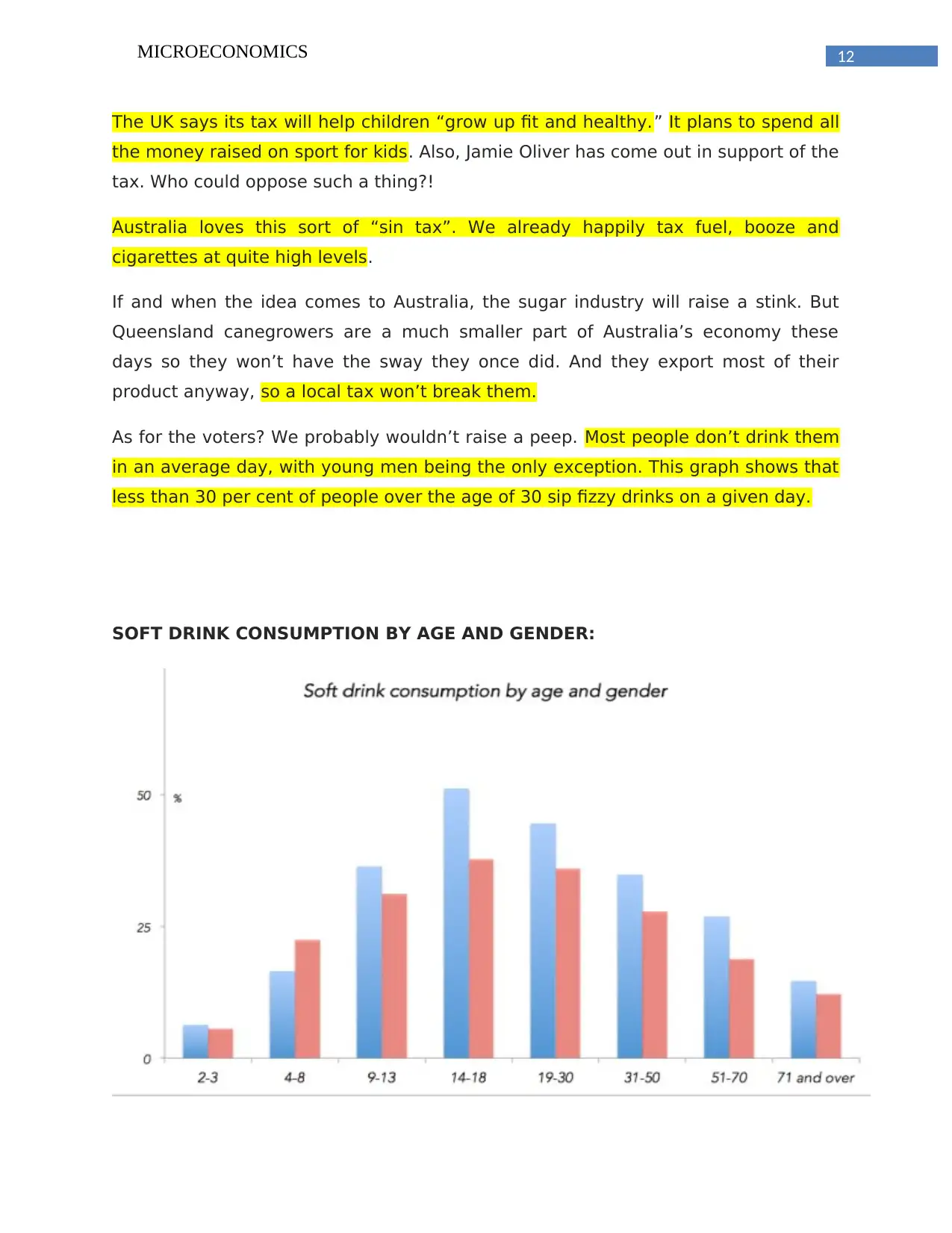
12MICROECONOMICS
The UK says its tax will help children “grow up fit and healthy.” It plans to spend all
the money raised on sport for kids. Also, Jamie Oliver has come out in support of the
tax. Who could oppose such a thing?!
Australia loves this sort of “sin tax”. We already happily tax fuel, booze and
cigarettes at quite high levels.
If and when the idea comes to Australia, the sugar industry will raise a stink. But
Queensland canegrowers are a much smaller part of Australia’s economy these
days so they won’t have the sway they once did. And they export most of their
product anyway, so a local tax won’t break them.
As for the voters? We probably wouldn’t raise a peep. Most people don’t drink them
in an average day, with young men being the only exception. This graph shows that
less than 30 per cent of people over the age of 30 sip fizzy drinks on a given day.
SOFT DRINK CONSUMPTION BY AGE AND GENDER:
The UK says its tax will help children “grow up fit and healthy.” It plans to spend all
the money raised on sport for kids. Also, Jamie Oliver has come out in support of the
tax. Who could oppose such a thing?!
Australia loves this sort of “sin tax”. We already happily tax fuel, booze and
cigarettes at quite high levels.
If and when the idea comes to Australia, the sugar industry will raise a stink. But
Queensland canegrowers are a much smaller part of Australia’s economy these
days so they won’t have the sway they once did. And they export most of their
product anyway, so a local tax won’t break them.
As for the voters? We probably wouldn’t raise a peep. Most people don’t drink them
in an average day, with young men being the only exception. This graph shows that
less than 30 per cent of people over the age of 30 sip fizzy drinks on a given day.
SOFT DRINK CONSUMPTION BY AGE AND GENDER:
⊘ This is a preview!⊘
Do you want full access?
Subscribe today to unlock all pages.

Trusted by 1+ million students worldwide
1 out of 15
Related Documents
Your All-in-One AI-Powered Toolkit for Academic Success.
+13062052269
info@desklib.com
Available 24*7 on WhatsApp / Email
![[object Object]](/_next/static/media/star-bottom.7253800d.svg)
Unlock your academic potential
Copyright © 2020–2025 A2Z Services. All Rights Reserved. Developed and managed by ZUCOL.





